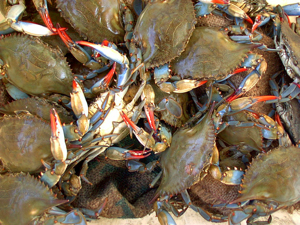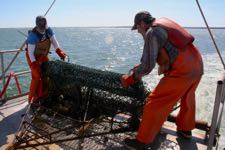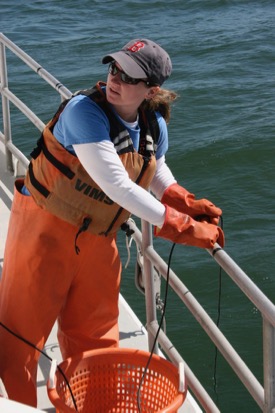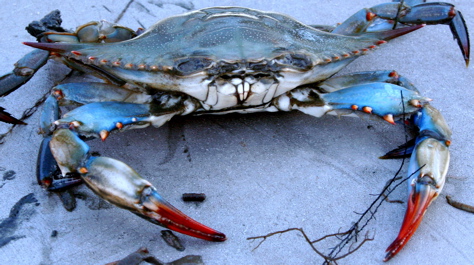Blue crab stock remains within healthy range
Species shows resilience despite general decline in abundance
Results from the latest Blue Crab Winter Dredge Survey—conducted annually by the Virginia Institute of Marine Science and Maryland Department of Natural Resources—show the Chesapeake Bay’s blue crab stock remains resilient and within healthy ranges.
The results—available due to months of field sampling and laboratory analysis by VIMS researchers Mike Seebo, Katie Knick, Gabby Saluta, Alison Smith, and colleagues at Maryland DNR—were announced by the Virginia Marine Resources Commission and Maryland DNR leadership.
While abundance did decline in most aspects in 2020, it remains within the normal, healthy range. The combined abundance of all ages of blue crabs declined by a third, from 594 million crabs in 2019 to 404 million crabs in 2020. This change was largely driven by a 43% decrease in the recruitment of juveniles. While 2019 saw a year of excellent recruitment with 324 million new crabs, 2020 saw only 185 million juveniles added to the population.
“The recent blue crab winter dredge survey shows us we have a healthy and robust blue crab population in the Chesapeake Bay,” says VMRC Commissioner Steven Bowman. “However, it also tells us we need to continue with our precautionary, science-based management approach to ensure we do not see further decreases.”
Professor Rom Lipcius, who oversees the Blue Crab Winter Dredge Survey at VIMS, adds "The blue crab population remains at a relatively high and stable level of abundance since management imposed effective actions in 2008 to trigger recovery of the population following 15 years of decline.”
Lipcius notes that the 2019 results warrant no further management actions this year. “The population is relatively stable,” he says. “The stock is not overfished, and overfishing is not occurring.”
Bowman concurs. “We don’t expect this will change our 2020 management measures for blue crab, and we will continue to manage blue crabs based on the best available science.”
 Blue crabs are a Chesapeake Bay icon and important commercial and recreational species. They are also a highly variable species, whose annual population depends on winds, currents, Bay temperatures, as well as predation by the many other species that rely on them for food.
Blue crabs are a Chesapeake Bay icon and important commercial and recreational species. They are also a highly variable species, whose annual population depends on winds, currents, Bay temperatures, as well as predation by the many other species that rely on them for food.
"We know blue crab populations fluctuate, so we must continue investing in Chesapeake Bay water quality and habitat restoration to ensure those fluctuations stay within a healthy range," says Secretary of Natural Resources Matthew J. Strickler.
2019 results in context
Scientists and managers measure one year’s abundance against a healthy range derived from results of years past, because annual population increases and decreases are to be expected.
A healthy population of spawning-age female crabs is the key to maintaining a healthy population throughout the Bay. While the population of adult female crabs decreased from 191 million in 2019 to 140 million in 2020 and is below the target abundance of 215 million, this year’s female abundance is still twice the minimum safe level of 70 million crabs. The female population has been above the threshold in 9 of the last 10 years, demonstrating a healthy spawning stock and resilience to annual variations.
The 2019 estimated harvest of both female and male crabs decreased, but was well within a healthy range. Even with lower exploitation, the 2019 bay-wide commercial harvest increased by nearly 6 million pounds for a total blue crab harvest of 61 million pounds. Virginia’s commercial harvest alone was over 28 million pounds and had a dockside value of $34 million.
 The Winter Dredge Survey, which VIMS and Maryland DNR have conducted annually since 1989, is the primary census of the Bay’s blue crab standing stock. Survey scientists employ crab dredges that sample blue crabs at 1,500 sites throughout the Chesapeake Bay. Sampling during winter, when blue crabs are usually buried in the sediment and stationary, allows them to develop, with good precision, estimates of the number of crabs present in the Bay.
The Winter Dredge Survey, which VIMS and Maryland DNR have conducted annually since 1989, is the primary census of the Bay’s blue crab standing stock. Survey scientists employ crab dredges that sample blue crabs at 1,500 sites throughout the Chesapeake Bay. Sampling during winter, when blue crabs are usually buried in the sediment and stationary, allows them to develop, with good precision, estimates of the number of crabs present in the Bay.
The Chesapeake Bay Stock Assessment Committee, a subcommittee of the Sustainable Fisheries Goal Implementation Team, will review the new survey results in mid-May and will release a full analysis in their annual Blue Crab Advisory Report this summer. The annual advisory report is used by managers for Virginia, Maryland, and the Potomac River as they review and update fishery regulations.
A VMRC press release states, “The Bay jurisdictions have a long history of cooperative management of the shared blue crab stock and will continue to do so to preserve our blue crab population and fisheries.”










